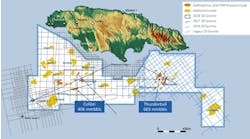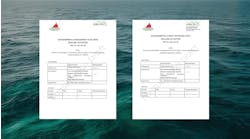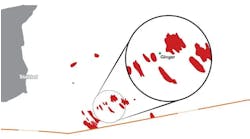ABS will class ChevronTexaco's Tahiti truss spar, destined for the deepwater Gulf of Mexico. Targeted for 4,200 ft of water, Tahiti demonstrates the industry's latest innovations, according to ABS.
Tahiti is the first spar with no drilling capability and no surface wellheads and is among the first spar projects to employ ABS's industry-first guide for building and classing specialized deepwater floating production units, Dick Vukin, ABS project manager, says.
ABS reissued its "Guide for Building and Classing Floating Production Installations" in April 2004 to include specific guidance for spars and TLPs. Developed in response to emerging technological advances in spar and TLP design, the update incorporates ABS's experience in classing these units while emphasizing the global performance issues and motion characteristics unique to this type of floating structure.
The Tahiti contract marks the industry's fifteenth spar, with ABS having classed 14 of the units. ABS will class Tahiti as an A1 floating offshore installation (FOI). FOIs include spars, semisubmersibles, and TLPs, in addition to ship-type process and storage facilities.
Classification will cover Tahiti's hull, mooring systems, topsides, power generation, platform layout, and all marine, utility and safety systems, including life-saving equipment and fire-fighting appliances. The classification will not include the hydrocarbon production facilities.
ABS also will act on behalf of the US Coast Guard and as a certification verification agent for the US Minerals Management Service. CVA review and approval for Tahiti will include structural design, fabrication, and installation.
Tahiti, planned for Green Canyon blocks 640, 641, and 596, is ChevronTexaco's second ABS-classed FOI for installation in the GoM. The first was the Typhoon TLP, installed in 2001. Chevron also operates the Genesis spar, installed in the GoM in 1998.
Tahiti will be the thirtysecond FOI in the US offshore industry, with ABS having classed 24 of the units. The remaining eight FOI units are not classed; however, ABS has completed CVA evaluations of the structural design of each unit.
There are presently 20 TLPs and 15 spars installed worldwide, with an estimated 20 new TLPs and another 30 spars expected over the next decade, making the ABS FPI guide a valuable tool for facilitating marine safety for these units industry-wide, Vukin says.
While the FPI Guide addresses column-stabilized units and other types of floaters, key areas of emphasis in the latest edition include global performance requirements, load and environmental issues, stability parameters, and structural strength criteria for spars and TLPs.
New requirements in the guide address modules and topside buildings, such that the design of these components is consistent with the overall structural analysis. "Structural verification of topsides modules and buildings will promote overall safety on these deepwater installations," Vukin says.
02/22/05


